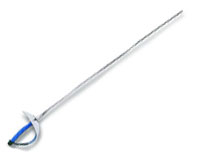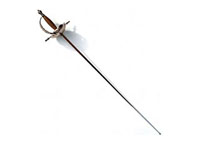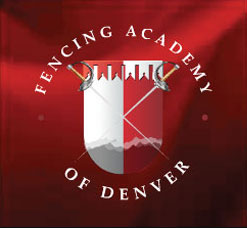The Weapons of Fencing
Fencing, which is also known as modern fencing to distinguish it from historical fencing, is a family of combat sports using bladed weapons. Fencing is one of four sports which have been featured at every one of the modern Olympic Games. Three types of weapon are used in Olympic fencing.

Sabre (Our Academy specializes in this weapon.)
A light cutting and thrusting weapon that targets the entire body above the waist, except for the hands. The sabre is primarily used to slash, so hits with the side of the blade as well as the tip are valid. "Right of way" applies—only one fencer can score at a time.
The cross-section of the sabre blade is Y- or V-shaped, unlike the quadrangular shape of the foil, but not as stiff as the épée. Adult (Size 5) blades are 88 cm (35 inches) in length. At the end of the blade, the point is folded over itself to form a "button", although no actual button exists. The bell guard of the sword is curved around the handle, giving the fencer hand protection. On electrical sabres, a socket for the body wire is found underneath the bell guard. A fastener known as a pommel is attached to the end of the sword to keep the bell guard and handle on. The handle of a sabre is standardly a straight saber grip, as other grips are incompatible with the bell guard. The entire weapon is generally 105 cm (41 inches) long; the maximum weight is 500g, but most competition swords are much lighter, closer to 100g. It is shorter than the foil or épée, and lighter than the épée, making it easier to move swiftly and incisively. Many equate the sabre's blade to a matchstick, in that they are easy to snap but relatively cheap to replace.
Épée
A heavy thrusting weapon that targets the entire body. All hits must be with the tip and not the sides of the blade. Épée allows simultaneous hits by both fencers.
The épée has a three-sided blade, in contrast to the foil and sabre which are rectangular in cross section. In competitions a valid épée touch is scored if a fencer touches the opponent with enough force to depress the tip; by rule, this is a minimum force of 750 grams-force (7.4 N). Since the hand is a valid target, the bellguard is much larger than that of the foil. The bell guard is typically made of aluminum or stainless steel. The tip is wired to a connector in the bellguard, then to an electronic scoring device or "box." The bellguard, blade, and handle of the épée are all grounded to the scoring box to prevent hits to the weapon from registering as touches.

Foil
A light thrusting weapon that targets the torso, including the back, but not the arms. Hits are scored only with the tip; hits with the side of the blade do not count. Only a single hit can be scored by either fencer at one time. If both fencers hit at the same time, the referee uses the rules of "right of way" to determine which fencer gets the touch.
In modern sport fencing, the foil is used as a thrusting (or point) weapon only. Any contact with the side of the blade (a slap or slash) does not result in a score. Modern foils average 35 inches or 89 cm in length, and have standardized, tapered, quadrangular blades which are designed to present a blunt (and therefore non-lethal) tip should they snap. To score a touch, one must touch an opponent with the tip of the foil with a force of over 4.90 newtons (500 grams-force).
